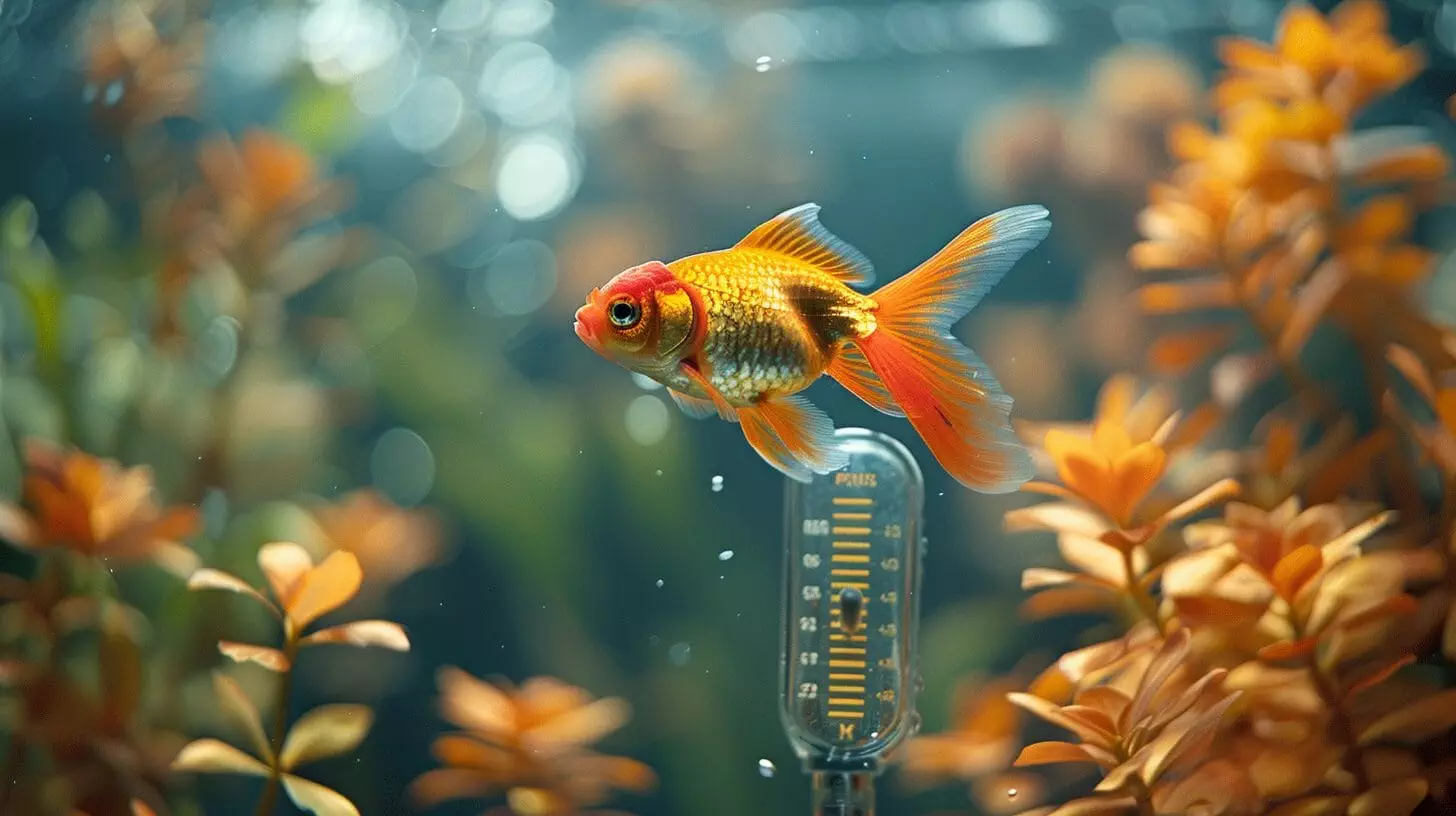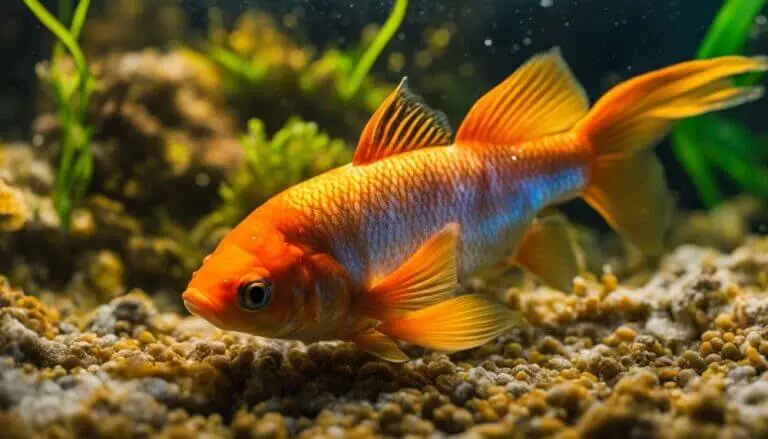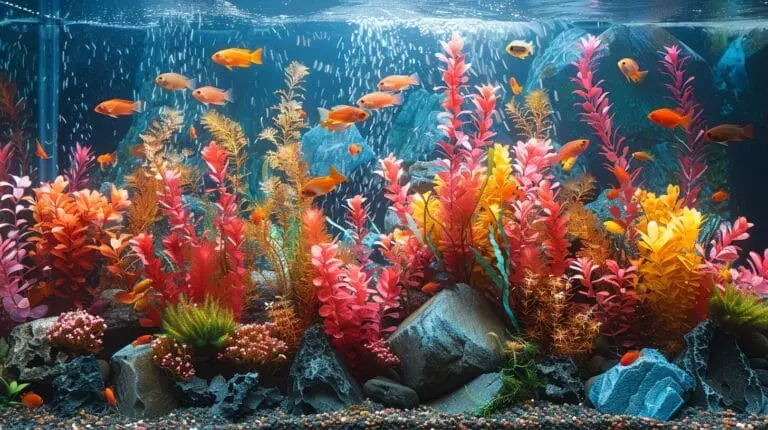Maintaining the ideal temperature for your goldfish is a key factor in ensuring their health and well-being. We all want our aquatic companions to thrive, and understanding the temperature range that goldfish prefer is essential. When it comes to maintaining the ideal temperature for your goldfish, a quality pond liner is crucial. Researching the best adhesive options for pond liner will ensure that your aquatic friends are living in the best possible environment. By investing in the proper materials for your pond, you can create a sustainable and comfortable habitat for your goldfish to thrive.
So, what temperature do Goldfish like? Let’s explore the intricacies of providing the right environment for these fascinating creatures and uncover the secrets to a successful goldfish tank setup.
Key Takeaways
- Goldfish prefer temperatures between 65-72°F (18-22°C) for optimal health.
- Temperature fluctuations can stress fish and weaken their immune system.
- Use a reliable thermometer to monitor and maintain the ideal temperature.
- Consider using an aquarium heater for stable temperature regulation.
- Sudden temperature changes can be harmful to goldfish.
Understanding the Importance of Temperature in a Goldfish Tank
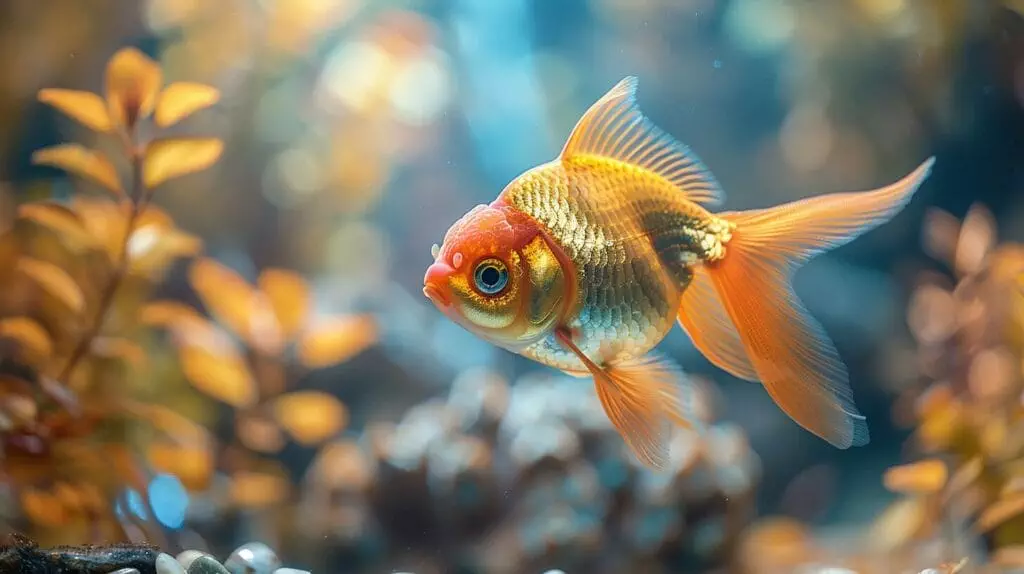
Goldfish are naturally adapted to cooler waters, making the maintenance of the right temperature pivotal for their overall health. Fluctuations in temperature can significantly impact their behavior, causing stress and potentially leading to health issues.
When the temperature strays too far from their comfort zone, goldfish may become sluggish, lose their appetite, or show signs of distress. As cold-water fish, they are particularly sensitive to warmer temperatures, which can reduce their oxygen levels and make them more susceptible to diseases.
Determining the Ideal Water Temperature for Your Goldfish
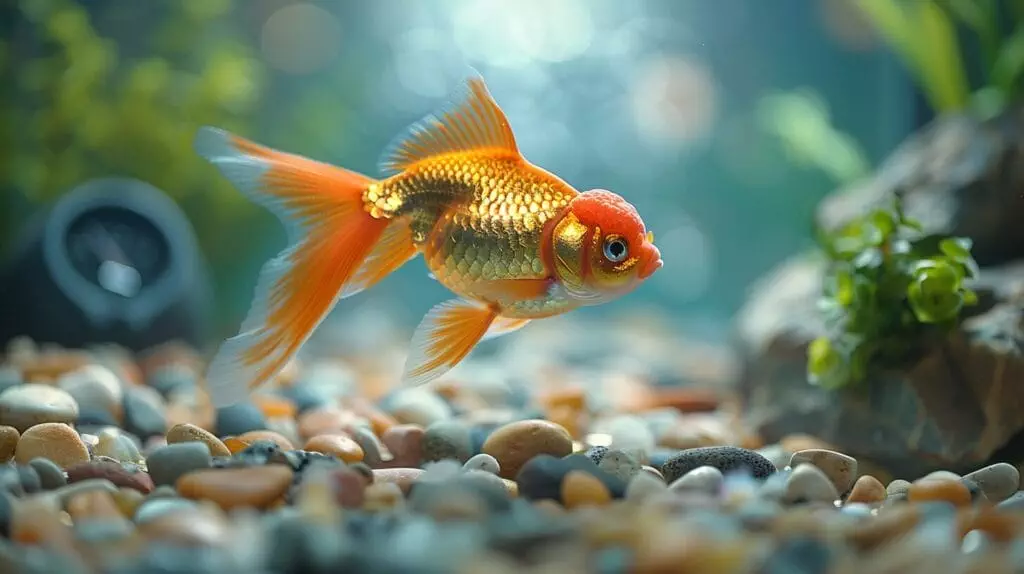
Goldfish thrive in temperatures between 65-72°F (18-22°C). Fluctuations outside this range can stress your fish, weaken their immune system, and even lead to illness. Sudden changes in temperature can be harmful, so it is essential to make adjustments gradually. Employing a reliable aquarium thermometer and a heater, if necessary, is recommended to provide a stable temperature. Remember, temperature affects your goldfish’s metabolism, digestion, and overall behavior.
Recognizing Signs of Problems Due to Incorrect Goldfish Water Temperature
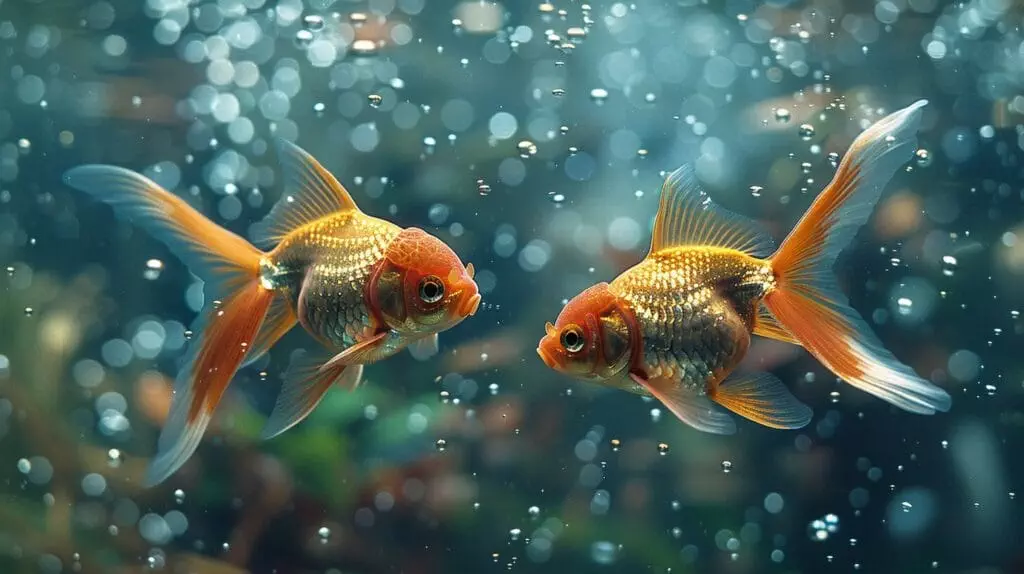
Inadequate water temperature can profoundly impact the well-being of your goldfish, manifesting noticeable behavioral and physical changes. Goldfish in overly warm water may become lethargic, gasp at the surface for air, or even have difficulty swimming.
Conversely, in cold water, they may become inactive, eat less, and their immune systems could weaken, making them more susceptible to diseases. Physical signs of temperature stress include rapid gill movement, erratic swimming patterns, or even skin lesions.
Using Equipment to Monitor and Control Goldfish Tank Temperature
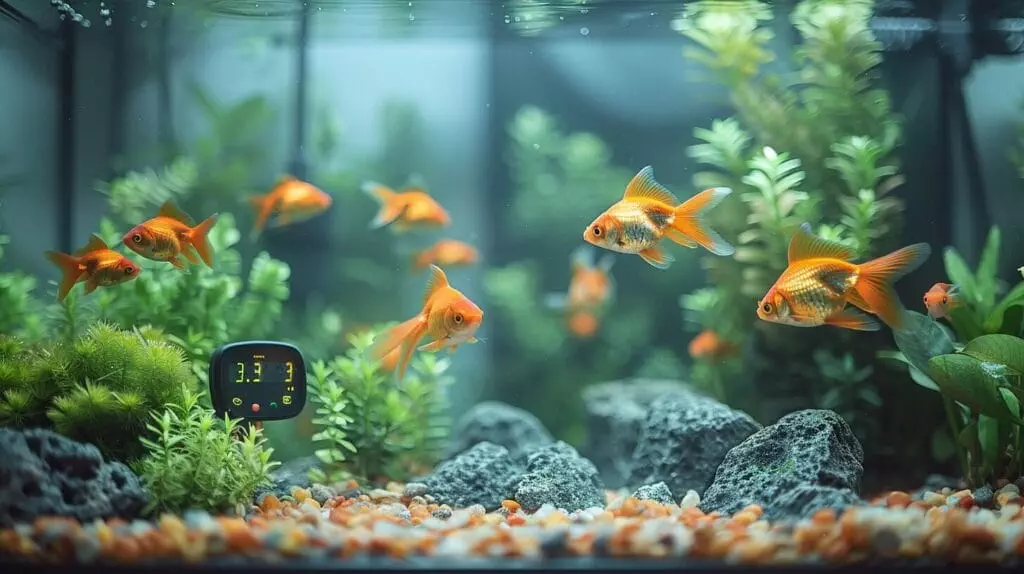
Various types of aquarium thermometers are available, including strip, digital, and floating thermometers, allowing you to select the one that best suits your needs. Additionally, an aquarium heater can help maintain the ideal temperature, typically between 65-72°F (18-22°C). In warmer climates or during summer months, a chiller can be used to prevent the water temperature from rising too high.
However, it’s essential to weigh the pros and cons of using a chiller, as they can be costly and may not always be necessary depending on your specific circumstances.
Tips for Maintaining the Perfect Temperature in Your Goldfish Tank
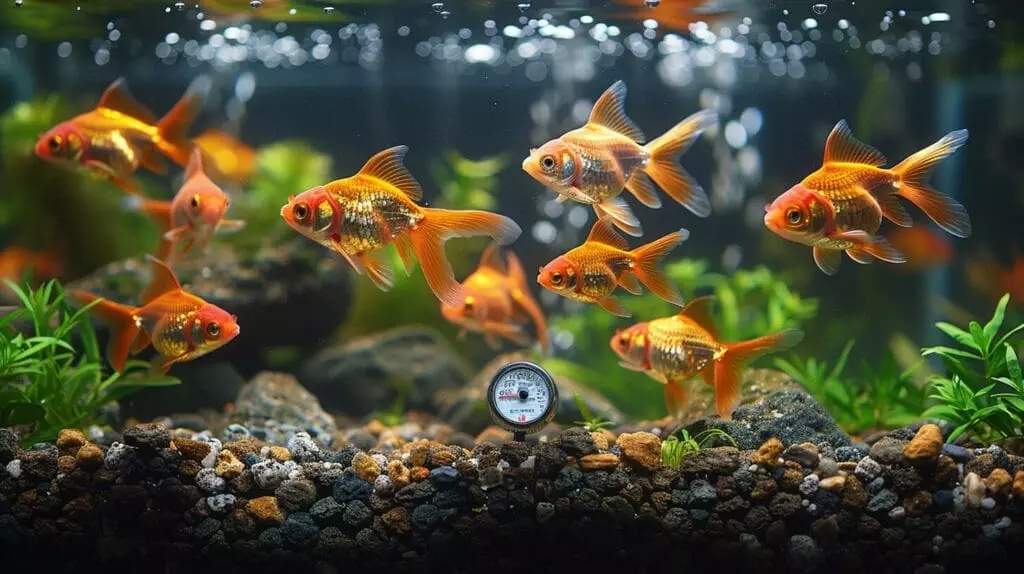
To insulate your tank against sudden temperature changes, place it away from windows or drafty areas. Using a tank heater with a thermostat can help regulate the water temperature, ensuring it stays within the ideal range for your goldfish.
Seasonal adjustments are crucial to account for temperature variations throughout the year. Monitor the water temperature regularly and adjust the heater settings as needed. During hot summers, keep your tank away from direct sunlight and use fans to cool the water if necessary. In colder months, insulate the tank with a cover or blanket to retain heat.
How Does Water Temperature Affect Goldfish Health in a Bowl Environment?
When it comes to goldfish bowl care tips, water temperature plays a crucial role in goldfish health. Maintaining a consistent temperature between 65-72°F is essential for their well-being. Drastic changes can stress the fish and make them susceptible to illness. It’s important to monitor and regulate the water temperature to ensure a healthy environment for your goldfish.
Conclusion
To summarize, maintaining the right temperature in your goldfish tank is essential for the health and well-being of your aquatic pets. By ensuring the water temperature stays within the ideal range of 65-72°F (18-22°C), you can help your goldfish thrive and avoid potential health issues.
Remember to monitor the temperature regularly, use appropriate equipment, and provide a stable environment for your goldfish to enjoy a happy and healthy life.
Frequently Asked Questions
What temperature range is ideal for goldfish?
Goldfish are hardy fish that can tolerate a wide range of temperatures. The ideal range for keeping fancy goldfish is between 65-72°F (18-22°C), while common goldfish can thrive in temperatures as low as 50°F (10°C). Goldfish are also sensitive to poor water quality, so it is important to provide them with a clean and well-maintained environment. Regular water changes and the use of a good quality filtration system are essential for keeping your goldfish healthy. Additionally, proper goldfish bowl care tips include providing them with a suitable sized tank or bowl, as they can quickly outgrow small containers. It is recommended to provide at least 20 gallons of water for a single fancy goldfish, and even more for multiple goldfish.
How does temperature affect goldfish growth rate?
Higher temperatures can speed up the metabolism of goldfish, leading to an increase in their growth rate. On the other hand, lower temperatures can slow down their growth.
Are goldfish affected by seasonal temperature changes?
Goldfish can tolerate seasonal temperature changes quite well. They can adapt to colder temperatures in winter and warmer temperatures in spring, although rapid temperature fluctuations can have a negative long-term effect on their health.
Do goldfish need a heater in their tank?
Fancy goldfish typically require a heater to maintain a consistent temperature, especially if kept indoors where the temperature might fluctuate. Common goldfish, however, can tolerate a wider range of temperatures and may not need a heater.
How can I replicate the natural temperature conditions for my goldfish?
To replicate the natural temperature conditions for your goldfish, make sure to keep the tank in a room where the temperature remains stable and avoid placing the tank near radiators or drafty areas that can cause sudden temperature fluctuations.

